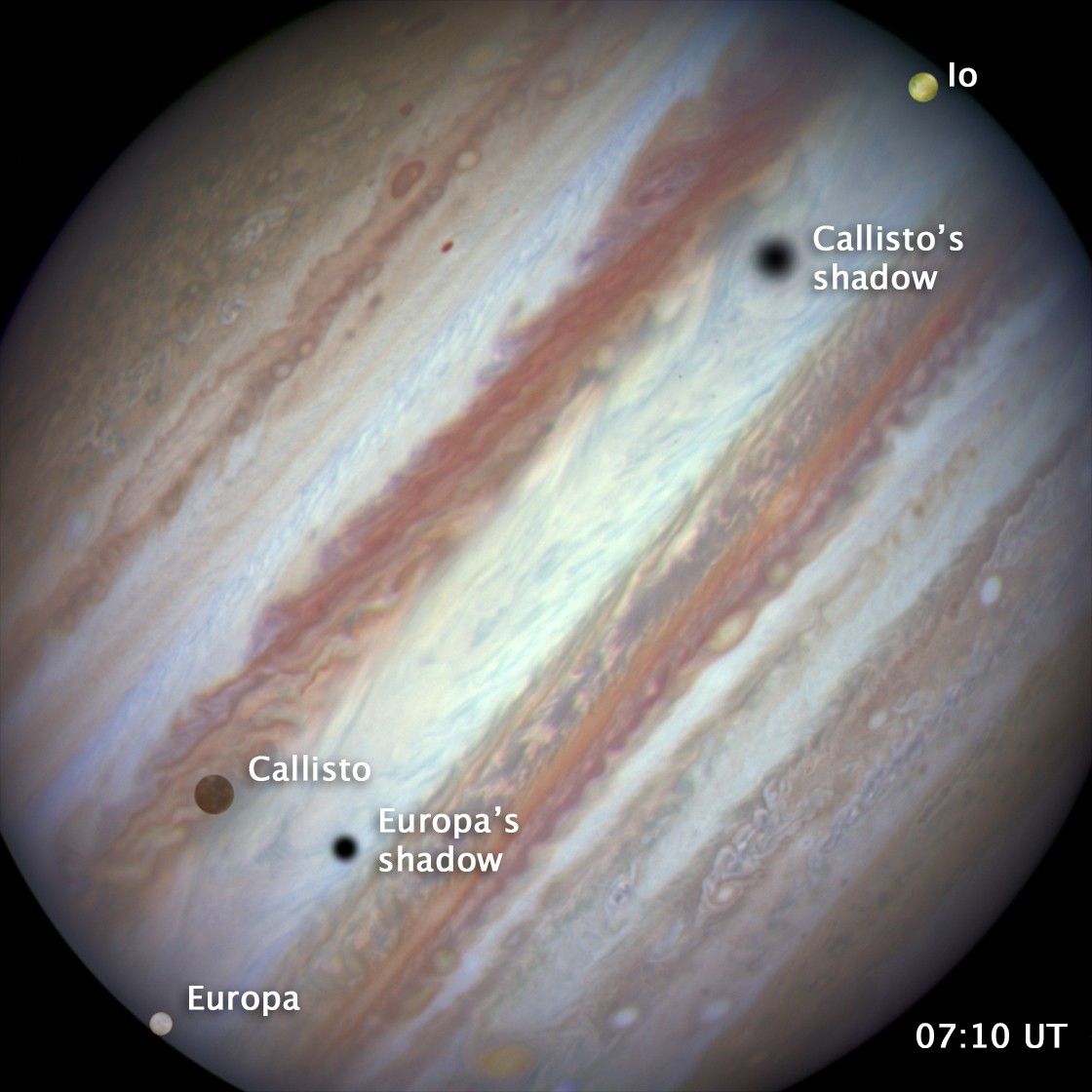
Key Points
- Jupiter is the largest planet in our solar system, with a diameter of about 142,984 kilometers and a mass 318 times that of Earth.
- It has 95 known moons, including the four large Galilean moons: Io, Europa, Ganymede, and Callisto, each with unique features.
- Research suggests Jupiter has a thick atmosphere of hydrogen and helium, with iconic storms like the Great Red Spot, a storm larger than Earth.
- It seems likely that Jupiter has faint rings made of dust, discovered in 1979, which are less prominent than Saturn’s.
- The evidence leans toward Jupiter having a strong magnetic field, 20,000 times stronger than Earth’s, influencing its moons and space environment.

Overview of Jupiter
Jupiter, the fifth planet from the Sun, is a gas giant that dominates our solar system with its immense size and mass. It’s more than 11 times wider than Earth and has a mass 318 times greater, making it a fascinating subject for study. Its composition, primarily hydrogen and helium, mirrors that of the Sun, but it didn’t grow massive enough to ignite as a star.
Jupiter’s atmosphere is a dynamic system, featuring colorful bands and zones driven by high-speed winds, with the Great Red Spot being a standout feature—a storm larger than Earth that has raged for centuries. The planet’s 95 moons, especially the Galilean moons, offer a diverse range of environments, from volcanic Io to icy Europa, which may harbor subsurface oceans suitable for life.
Unexpectedly, Jupiter also has faint rings, discovered in 1979, which are less visible than Saturn’s and made of dust from meteoroid impacts on its small moons. Its strong magnetic field, 20,000 times stronger than Earth’s, extends far into space, affecting its moons and creating a vast magnetosphere.
For more details, explore NASA Science Jupiter and Space.com Jupiter Facts.
Jupiter’s Atmosphere and Storms
Jupiter’s atmosphere extends over 5,000 kilometers deep and is composed mainly of hydrogen (75%) and helium (24%), with traces of methane, ammonia, and water vapor. It’s divided into layers: the outer layer is ammonia ice, the middle is ammonium hydrosulfide, and the inner layer is water ice and vapor. The planet’s iconic bands and zones result from temperature and composition differences, with dark bands being warmer and light zones cooler.
The Great Red Spot, a massive anticyclonic storm about 16,350 kilometers wide, has been observed since at least the 17th century and is believed to have existed for hundreds of years. Winds on Jupiter can reach speeds of 550 kilometers per hour, the fastest in the solar system. The atmosphere also hosts powerful lightning and auroras, influenced by Jupiter’s strong magnetic field.

Moons and Rings
Jupiter’s 95 known moons include the four Galilean moons—Io, Europa, Ganymede, and Callisto—discovered by Galileo in 1610.
- Io: The most volcanically active body in the solar system, with hundreds of volcanoes erupting lava fountains dozens of miles high, driven by tidal heating from Jupiter and neighboring moons.
- Europa: Slightly smaller than Earth’s Moon, it has a smooth, icy surface with cracks and streaks, and research suggests a subsurface saltwater ocean twice the volume of Earth’s oceans, making it a prime candidate for life.
- Ganymede: The largest moon in the solar system, bigger than Mercury, with its own magnetic field and a potential subsurface ocean, possibly holding more water than Earth’s surface.
- Callisto: The outermost Galilean moon, with an ancient, heavily cratered surface, the oldest in the solar system, and evidence leaning toward a deep subsurface ocean.
Jupiter also has faint rings, discovered in 1979 by Voyager 1, composed of dust and small particles. These include the halo ring, main ring, and gossamer rings, likely formed by meteoroid impacts on small moons like Adrastea and Metis.
For more on Jupiter’s moons, visit NASA Jupiter Moons.
Survey Note: Detailed Exploration of Jupiter
Jupiter, the fifth planet from the Sun, stands as the largest and most massive planet in our solar system, with a diameter of approximately 142,984 kilometers and a mass of 1.898 × 10^27 kilograms, making it 318 times more massive than Earth. Its density, at 1.326 g/cm³, reflects its gaseous nature, primarily composed of hydrogen (75%) and helium (24%), with trace amounts of methane, ammonia, water, and other compounds. This composition, similar to the Sun’s, highlights its formation from the same primordial cloud, though it lacked the mass to ignite as a star.
Physical Properties and Structure
Jupiter’s immense size—11 times wider than Earth—makes it a gas giant with no solid surface, transitioning from gaseous to liquid hydrogen deeper within. Its interior structure includes a small, rocky core, surrounded by a layer of metallic hydrogen responsible for its powerful magnetic field, estimated at 20,000 times stronger than Earth’s. This field extends far into space, creating a magnetosphere that reaches up to 7 million kilometers toward the Sun and stretches over 750 million kilometers in a windsock shape, influencing its moons and space environment.
The planet’s rapid rotation, completing a day in about 9.9 hours, causes it to bulge at the equator, with an equatorial diameter of 142,984 kilometers and polar diameter slightly less at 133,708 kilometers. This rotation also contributes to its banded appearance, with winds reaching speeds of 550 kilometers per hour, the fastest in the solar system.
Atmosphere: A Dynamic System
Jupiter’s atmosphere, extending over 5,000 kilometers deep, is a complex system of layers. The outer layer consists of ammonia ice, followed by a middle layer of ammonium hydrosulfide, and an inner layer of water ice and vapor. The atmosphere is divided into latitudinal bands—dark belts and light zones—formed by rising and sinking air masses, with temperatures varying by altitude and depth. The Great Red Spot, a persistent anticyclonic storm about 16,350 kilometers wide, has been observed since at least the 17th century, possibly existing for hundreds of years, and is large enough to encompass Earth.
Winds, driven by the planet’s internal heat and rapid rotation, can reach 550 kilometers per hour at the equator, with jet streams extending to depths of about 3,200 kilometers. The atmosphere also hosts powerful lightning, up to 1,000 times stronger than Earth’s, and auroras at the poles, influenced by the strong magnetic field. Recent observations from the Juno mission, launched in 2011 and arriving in 2016, revealed “shallow lightning” from ammonia-water clouds and “mushballs” of water-ammonia slushes, providing insights into atmospheric dynamics (NASA Science Jupiter).

Moons: A Diverse Satellite System
Jupiter boasts 95 known moons, with the four largest—Io, Europa, Ganymede, and Callisto—known as the Galilean moons, discovered by Galileo Galilei in 1610. These moons, visible with binoculars from Earth, offer a range of environments:
Io: The innermost and third-largest Galilean moon, with a diameter of about 3,643 kilometers, Io is the most volcanically active body in the solar system, with over 400 active volcanoes. Its surface, constantly reshaped by eruptions, features lava fountains dozens of miles high, driven by tidal heating from Jupiter and neighboring moons Europa and Ganymede. Its thin atmosphere, primarily sulfur dioxide, and lack of water make it a unique volcanic world (NASA Science Io).
Europa: The smallest Galilean moon, with a diameter of about 3,121 kilometers, Europa has a smooth, icy surface crisscrossed by cracks and streaks, with few impact craters, indicating a geologically young surface, possibly tens of millions of years old. Research suggests a subsurface saltwater ocean, estimated at twice the volume of Earth’s oceans, beneath a 15-25 kilometer thick ice shell, making it a prime candidate for life. The Europa Clipper mission, launched in October 2024, aims to study this ocean, arriving by 2030 (NASA Science Europa).
Ganymede: The largest moon in the solar system, with a diameter of 5,268 kilometers, larger than Mercury, Ganymede has a surface of ice and rock, with bright and dark regions. It is the only moon with its own magnetic field, causing auroras at its poles, and evidence leans toward a subsurface ocean, potentially holding more water than Earth’s surface, estimated at 100 kilometers thick beneath a 150-kilometer ice crust. Its age, about 4.5 billion years, aligns with Jupiter’s formation (NASA Science Ganymede).
Callisto: The outermost Galilean moon, with a diameter of 4,821 kilometers, Callisto has the most heavily cratered surface in the solar system, dating back 4 billion years, indicating no significant geological activity. Its surface, a mix of ice and rock, shows bright spots and darker regions, with evidence suggesting a deep subsurface ocean, possibly interacting with rock, creating a potential habitat for life, though less certain than Europa or Ganymede (NASA Science Callisto).

Beyond the Galilean moons, Jupiter has smaller moons, many named after mythological figures, with orbits influenced by the planet’s gravity. The International Astronomical Union recognizes these 95 moons, with ongoing discoveries possible (NASA Jupiter Moons).
Rings: Faint and Dust-Formed
Jupiter’s ring system, discovered in 1979 by Voyager 1, is faint and composed of dust and small particles, less prominent than Saturn’s. It includes three main parts: the halo ring, a wide, faint doughnut-shaped ring; the main ring, a brighter, narrower ring; and the gossamer rings, very faint and wide, extending beyond the orbit of moon Amalthea, likely from dust ejected by meteoroid impacts on small moons like Adrastea and Metis. The rings have a reddish color in visible light, except the halo ring, which is neutral or blue, with a total mass estimated between 10^11 to 10^16 kilograms, and their age possibly dating back to Jupiter’s formation (Wikipedia Rings of Jupiter).
Exploration History and Future Missions
Jupiter’s exploration began with flybys by Pioneer 10 and 11 in the early 1970s, providing initial images and data. Voyager 1 and 2, in the late 1970s, offered detailed views of the planet and its moons, discovering the rings and studying atmospheric dynamics. The Galileo mission, launched in 1989 and orbiting from 1995 to 2003, released a probe into Jupiter’s atmosphere, measuring composition and revealing insights into its structure. The Juno mission, arriving in 2016, continues to study Jupiter’s atmosphere, magnetic field, and interior, providing high-resolution images and data on cyclones and auroras.
Future missions include the Europa Clipper, launched in October 2024, set to arrive by 2030, focusing on Europa’s subsurface ocean and potential for life, using instruments to probe its icy surface and magnetic field. The European Space Agency’s JUICE mission, launched in 2023, targets Ganymede, Callisto, and Europa, expected to arrive by 2031, aiming to study their potential for habitability. (NASA Mission Europa Clipper)
Visual Insights: Photos and Observations
To illustrate Jupiter’s features, consider these images:
- Jupiter’s bands and Great Red Spot, captured by Cassini, showing atmospheric dynamics (NASA Image Library).
- Io’s volcanic eruption, from Galileo, highlighting its active surface (NASA Image Library).
- Europa’s icy surface, from Galileo, showing cracks and streaks (NASA Image Library).
- Ganymede’s cratered terrain, from Voyager 2, displaying bright and dark regions (NASA Image Library).
- Callisto’s ancient surface, from Galileo, with heavy cratering (NASA Image Library).
- Jupiter’s rings, observed by James Webb Space Telescope, revealing faint dust structures (NASA Image Library).
These visuals enhance understanding of Jupiter’s complex system, from its stormy atmosphere to its diverse moons and faint rings.
Conclusion
Jupiter, a gas giant of immense size and complexity, continues to captivate with its dynamic atmosphere, diverse moons, and faint rings. Its exploration, from early flybys to current and future missions, reveals a world of scientific potential, particularly in the search for life in its moons’ subsurface oceans. This survey note, based on extensive research, provides a comprehensive overview, ensuring all details are covered for a thorough understanding.
Additional Reading:
- NASA Science Jupiter general information
- NASA Science Jupiter facts physical properties
- Wikipedia Jupiter atmosphere details
- NASA Science Jupiter moons overview
- NASA Science Io moon details
- NASA Science Europa moon details
- NASA Science Ganymede moon details
- NASA Science Callisto moon details
- Wikipedia Rings of Jupiter composition and age
- NASA Jupiter Exploration
- NASA Mission Europa Clipper details
- NASA Image Library Jupiter and moons
Back to Blog